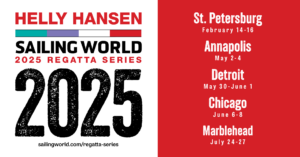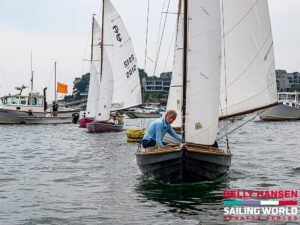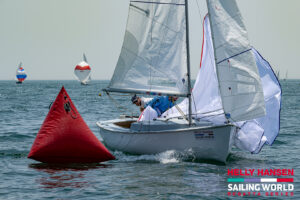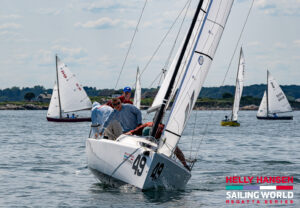The racing season is short enough as it is in Chicago, especially those years when the spring thaw is agonizingly glacial and the fall cold snap comes too soon. It used to be that things got pretty quiet around the Chicago YC in the offseason, but with the introduction of the DragonForce 65 last year, Lake Michigan locals are no longer forced sit at home and watch their once-great gridiron Bears stumble through another losing season.
That’s right, come wintertime, there’s plenty of round-the-buoys action down at Chicago YC’s Belmont Station where DragonForce fleet founder Daniel Burns is found holding court behind the glass panels of the floating clubhouse’s upper deck. Bobbing in the harbor are as many as 20 miniature sailboats crossing tacks and past anchored marks. There are no crews, nor shouting between boats, nor spinnakers going up down, rather elbows bumping in the clubhouse, joysticks clacking and the regular banter of model yacht racing enthusiasts. The rate at which the fleet is growing, Burns may have a leg to stand on when he says it’s the hottest wind-driven racing action in Chi-Town today.
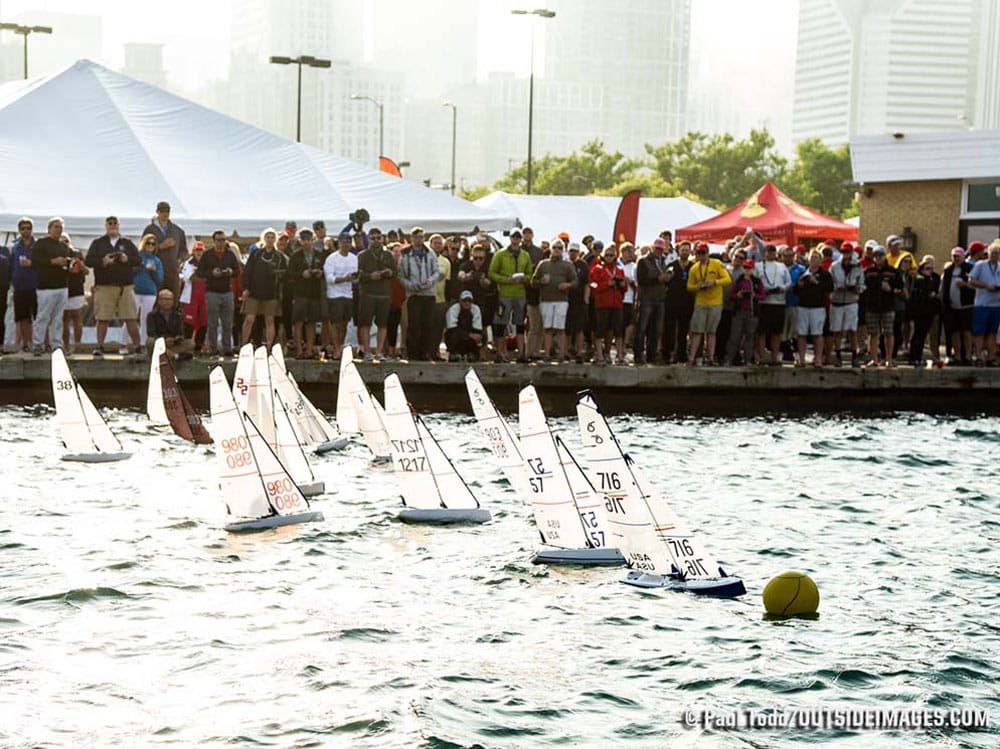
“This time last year, there were five boats, with me and a few friends,” says Burns. “Now, there’s about 107 in our fleet.” The variety of remote wielding sailors runs the gambit he says: kids, older seasoned sailors, local hotshots, and even the club’s flag officers.
The instigators were Burns and his friend Mikey Whitford. Not long ago they were looking at getting into “small” boat remote control sailing. They considered the RC Laser, but the Chinese-made DragonForce offered an attractive low-cost entry. The base boat can be had for $200, and the upgraded remote another $35. “They’re not hard to store or tote around,” says Burns, “some members just keep them in their sail locker.”
Burns never saw Chicago’s DragonForce fleet getting as popular as it is today but the low-cost and one-design nature of the class are appealing. There are other DragonForce fleets elsewhere in the country, mostly small in numbers, but nothing compares to the Chicago set.
During the winter “Iceberg Series,” he says, on days 40 degrees or warmer, competitors will bring the action outside at Belmont station, and using Bluetooth speakers and a pre-recorded starting sequence, they’ll knock off 10 races — easily. There’s little demand for race committee: just someone to manage the start, call the line, and record finishers. Once the turning marks are set, they stay put.
The most recent Iceberg series had 54 registrants with 33 boats typically on the starting line. The transmitters are digital so there’s plenty of room in the airwaves to prevent signals crossing. The only challenge, says Burns, is when competitors lose track of which boat is theirs. “We use the 2.4GHZ range, which is pretty quick,” says Burns. “The weirdest thing is when you’re looking at the wrong [someone else’s] boat.”
The pilot’s ability to tweak the DragonForce’s performance is limited once on the course, but before shoving it off to race there are plenty of adjustments to be made: forestay tension, jib-halyard tension, mainsail Cunningham, vang and outhaul as well the backstay. “We’re always trying to set it right for the conditions,” says Burns. “The sails like a lot of twist.”
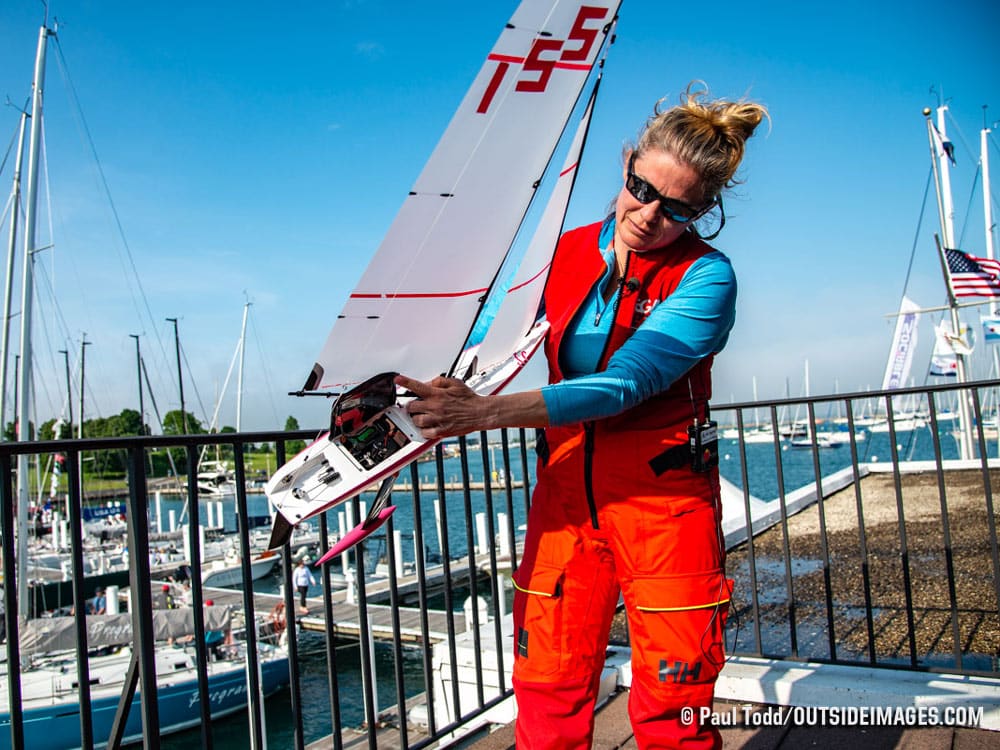
Once underway (no adjustments once the starting sequence is live), two motors (servos in RC-speak) allow adjustments of the rudder and the sails. The main and jib trim simultaneously to match leech profiles. “You’re either eased to 80 degrees true-wind angle, or fully trimmed in,” says Burns. There’s not much to be gained between the two macro trim settings.
The countdown alerts to one minute to warning, followed by a 1-minute countdown. “The starts can be chaotic as boats pace to leeward of the starting line. Burns prefers to hover above the line, swoop in and dip start with speed.
Once in irons, or slow, he says, it’s a challenge to get the boat to full speed again. A short beat and rounding of tether balls as race marks makes for one-lap races that run 6 to 10 minutes apiece. They use triangle courses as well and, occasionally, starboard roundings just to keep things interesting. “One time around minimizes the confusion of who’s going upwind and who’s downwind,” he says.
Burns, who regularly mans the pit on the local Farr 40 Hot Lips, is one of the top DragonForce dudes in the area, but there’s Lee Edwards, “an older gentleman cruiser and really smart.” He wins a lot of races.
While a passerby may see adults messing about with toys, the racing is in fact highly competitive says Burns. There’s plenty of bumping and grinding on the course, most of it incidental. “I was winning a race once when someone just T-boned me, and I think it was just because he didn’t know what to do. There wasn’t any damage, of course, but stopping a DragonForce is the worst thing possible because it can be hard to get it going again.
But all is good so long as everyone does their penalty turns, he says. “It’s like real sailing, just in a miniature form.”
Racing in anything more than 20 knots of wind is “harsh, but doable,” says Burns. The true challenge to the remote-control sailor is wave amplitude. The scale is like one foot to 10 feet in a real boat, so tacking is almost impossible when the waves get too big because they push the boat around. The Belmont Harbor’s protection, however, keeps the big-wave activity in check, so when conditions are deemed to sporty for racing big boats, you can be sure Chicago’s DragonForce sailors are plugging in fresh batteries and putting their antennas and egos on the line. No one’s getting wet, and the beer never spills.

